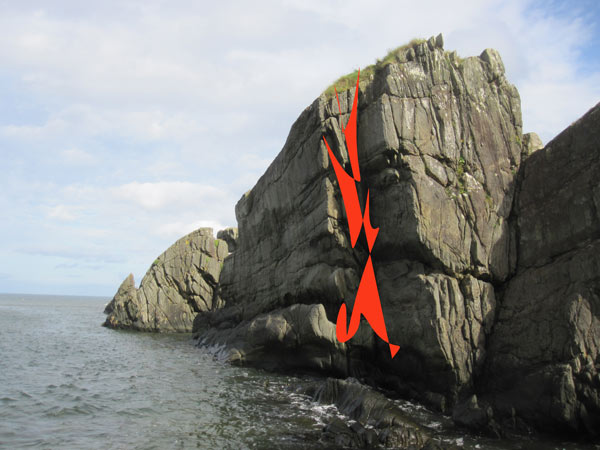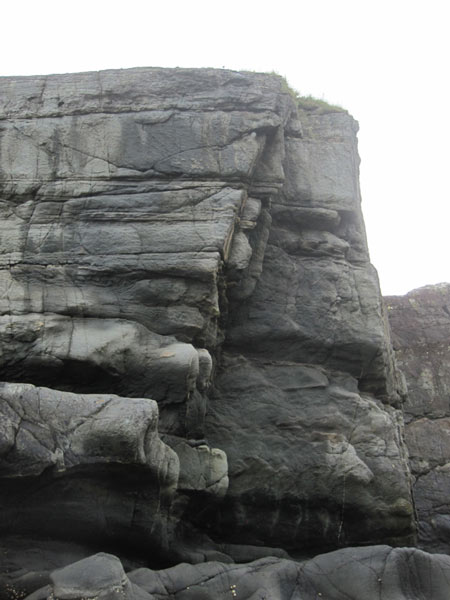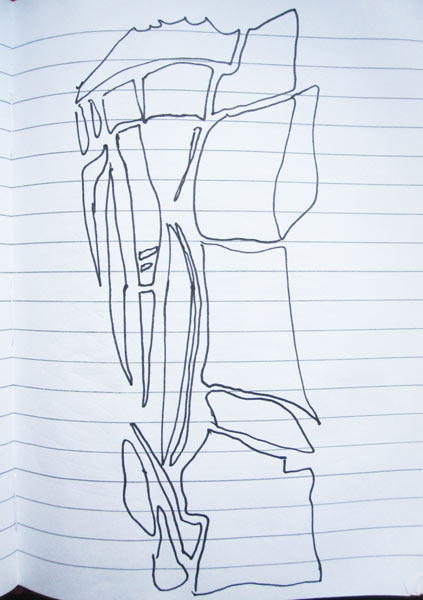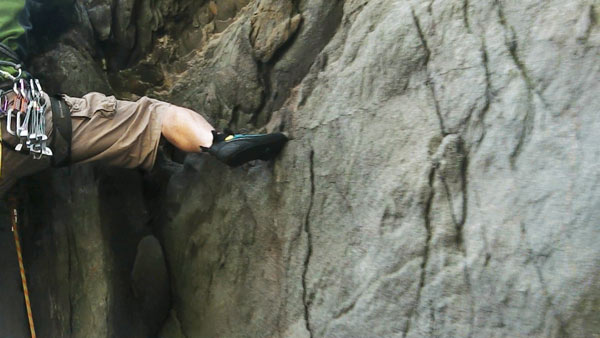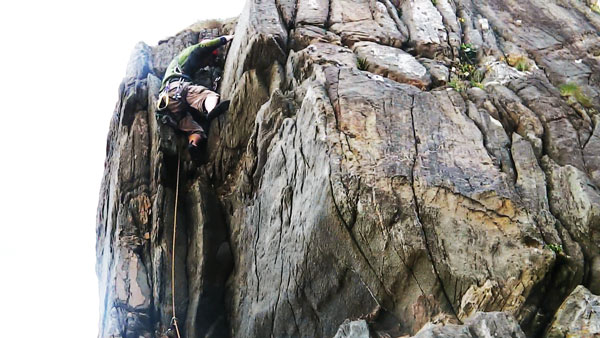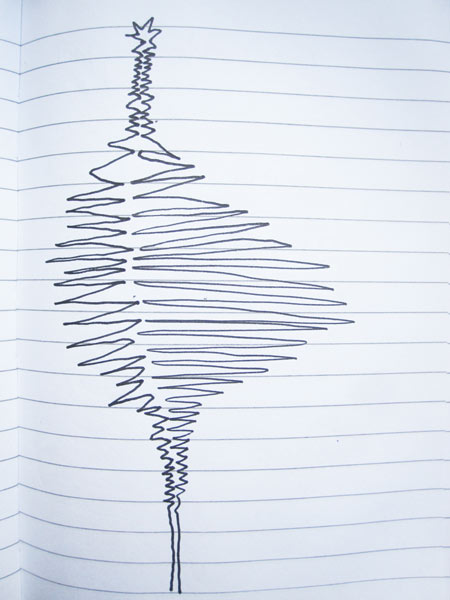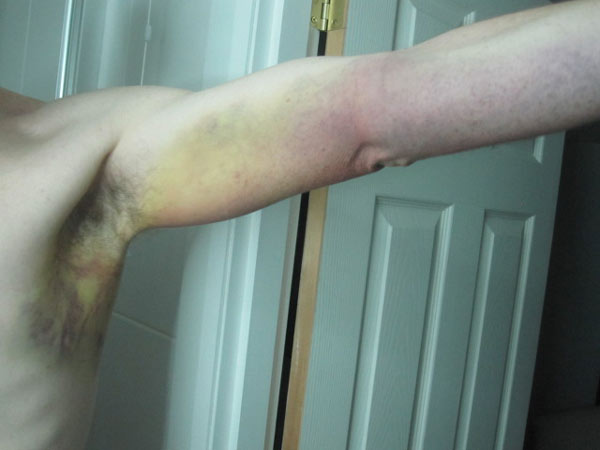Public Commission 16m HVS 4c+
The 3rd and overhanging corner seaward from the arch.
More strenuous than it looks.
Belay at low tide or from a hanging belay on middle slab (also avoids any potential rockfall)
Bridge and layback the corner.
Better gear nearer the top
The large worrysome sounding fin is best avoided if possible.
Some friable rock on left wall.
Love Hate.
Dan Shipsides Sep 2011
Public Commission 16m HVS 4c+ is a beautiful new climbing route by artist and climber Dan Shipsides. Its location is on a wild sea crag in Donegal. The route came into existence as a by-product of the cultural commissioning of a wider project. This new commission frames the new climbing route as a public artwork.
Could a climbing route be a public (art)work?
To what extent might it have been created or performed?
What form does it posses or take?
What is the location of the artwork?
What audiences might engage with it?
What is it that they do if they do?
Location: Port A Doris, Shroove, Inishowen, Donegal. 55.2ºN, 6.9°W
A plaque at the location provides a QR link to online images, drawings and texts relating to the route and it’s providence as an experiential and conceptually charged public artwork.
Public Commission 16m HVS 4c+ is presented as part of the 100x100 project, a program of art commissions on the route of the Inishowen 100, facilitated by Artlink. It was initially funded by Legacy Trust UK(under Vertical. Nature. Base - an Echo Echo Dance Co. and Dan Shipsides collaborative project) and subsequently funded by Artlink with the assistance of Inishowen Development Partnership, and the Department of Community, Equality and Gaeltacht Affairs.
Also supported by the Research Institute Art and Design, University of Ulster.
Following text by Dan Shipsides 2012
(How) Is this climbing route a public (art) commission?
Providence
In September 2011 I climbed a new route in Port a Doris – a first ascent – as far as anyone I know knows.
It is not listed in the Donegal guidebook or on the Donegal climbing website database so it's mine to claim - unless anyone knows otherwise in which case please let me know as I'd love to share notes.
It is a clear and obvious line but it is understandable if no-one has tried it prior – it’s tidal, a bit loose and quite over hanging. On the good side it’s quite a stunning line, looks relatively easy from the beach and looks like there a lot of scope for protecting the climb in a ground up manner (both the ‘easy’ and ‘lots of protection’ aspects turned out to be big misperceptions).
I’d been eyeing up the line for several months until I got a window to give it a go. I’d bouldered the low section a few times – the slippery tidal start always made this tricky - you have to get the tide timing right if you’re bouldering.
I thought hard about name for the route: I played around "Topophile / Topophobe" but I had various other ideas to. It was Topophile /Topophobe for a few months during the art/dance project and exhibition ‘Vertical. Nature. Base.’ during which developmental process the climb originated.
Commission
I’m interested in the idea of a climbing route being conceptualized as a public artwork. Here is a new climbing route has been made as a by-product of cultural funding. That’s not to say that if something is funded by cultural funding provision then it is art - that would be a stupid rational although often perhaps is the case – but, that it occurred during a funded art project gives me an opening to problematise what it is or what else it could be.
So now I've decided to use a second art commission structure to rename and further think the climbing route. As the climb came about due to a funded art process it seems appropriate to use this second opportunity to further work on the idea. Hence from now on I will call the new climbing route Public Commission 16m HVS 4c+.
It’s exciting and interesting to do this because it offers several problems and questions around:
The nature of the artwork – conceptual and experiential. The concrete nature of climbing the route (as a key mode of engaging with or ‘consuming’ the artwork) gives it a specifically phenomenological form. Potential engagement though is by several modes which range across actual climbing, in-situ watching and looking, mediated looking, watching, telling - reading, hearing discussing – many which may modulate or oscillate the artwork between it’s concrete nature and a conceptual nature.
Joined to this fluctuating ontology of the artwork is the ‘event-ness’ of the artwork. If we look at the artwork as an event – this has at least two temporal dimensions. The first imagines it as a document of a historical event – the first ascent – a performance. The second imagines it as an event or performance each time the route is climbed by anyone. We should however also recognize, though this is likely to be less concretely compelling, that each and every way the work is encountered through its various forms of mediations is an event in itself. To what extent does it exist as a historical event – the first ascent? to what extent does it exist as a potential contemporary event – someone climbing it? Or - to what extent, and in what form, does the mediated 'event' occur? So in other words - as an artwork in the world of ‘thingly things’ - what is it?
This complex and shifting nature of the artwork – it’s 'thinglyness' – is grounded in the question of where the artwork is. Where is it located? Concretely it is there – in the cove in Donegal - however if you go there without knowledge of it you might not find it. Conversely if you know about it without ever being in the cove then clearly the works’ conceptual nature has disseminated away from the local and concrete through some form of mediated process (printed matter, digital online media etc. – perhaps this text you are reading) rendering the then ‘location’ of the artwork destabilized – potentially nowhere, potentially anywhere, hopefully somewhere. Where are concepts and how are they beautiful?
The context and concepts of art is clearly a transformative agent here – a reliance on an art framing to give it value is recognizable. However it exists also within a different vernacular language through the context of rock climbing where it also has aesthetic, kinesthetic and socio-cultural value. In this context we may not consider it as an artwork. So does this act only serve to aestheticise vernacular culture? Or does it offer wider reflection on aesthetics, culture in relation to what people do and make?
It has aesthetic and kinesthetic form of definite quality (but maybe this is more identifiable to climbers). Aesthetic quality in terms of drama, beauty, criticality (it’s quite dangerous and tests the feasibility of what’s possible to climb in this location – easier lines are possible – so to take this line is to pursue it’s critical form) and has a strong kinesthetic – which follow a clear pleasure principle (even if that’s scary, potentially lethal or painful).
It was made by me; ‘authored” – is that the right word? 'created'? 'established'? 'put up'?
Well let’s look at that. I saw a possibility, studied, explored and thought hard about it. Then quite clumsily (by witness accounts) but successfully climbed it. The rock had been in my mind for at least six months – where I imagined, visioned, projected a possibility onto it – a line taking a specific feature – a deep over hanging corner. A critical line. So I feel it was a creative act – not particularly graceful (though in my mind there was some level of grace in the situation) – but when was grace central to contemporary art? It was a real kinesthetic experience – right from start to finish and the moments sat on the top of the rock stack. This experience was shaped by many elements - the rock, the sea, air, wind, the people with me, our conversations and communications over which my actions were both spread and were dictating - okay my actions did little to dictate the rock although that depends on a state of mind and faith.
So a new line now exists – a potential channel or passage of movement up this particular feature of rock. The line also exists through mediated sources as a mapping – a documentation of the line to be taken by other climbers – this line is invisible in relation to the actual rock – but it exists through mediation, consent or the agreement or knowledge that it’s there.
Concurrently and subsequently I added alternative and additional forms of mediation – text account, poetic text, topographic text, drawing before climbing, drawing after the climb graphic developments on the idea of the climbing route description and raw accounts of the act. Neither present a faithful reconstitution of the climbing event or concrete actuality of the rock but each adds a layer of mediation a 'coming to terms', rather than a 'coming to grips', with it.
Public / Audience
Potentially many - probably few.
Who exactly experiences or audiences it and in what ways?
There must be differing levels of engagement – here are some possibilities:
A climber who climbs it – having an embodied, phenomenological and psychological experience where he / she also authors their own experience – or rather exposes themselves to auto-authoring where the circumstances such as rock, sea, weather shape the experience. That climber might know there is an existing route (if they had studied the data on websites and guidebooks) - or they might not – in which case did they encounter an artwork?
Someone who witnesses someone climbing it.
Someone, likely a climber, who reads about the route – as perhaps written about or reported on by a another climber having climbed it or seen it and consequently writes, blogs or talks about as a contribution to climbing media or as personal conversation. This person might never climb it or even see it in the real.
So, of course, it’s possible and probably that one might also encounter this artwork without ever have been in the cove; Beside the route there is a small brass plate with a QR code etched in it - you might have encountered the work by scanning that code or linking the code as digitally shared by someone who originally scanned the plate in the cove. You may be reading this if you have somehow been directed or 'shared' to this page from an original scan of the QR code in the cove.
Then as an artwork you may encounter it via the infrastructure of the art project – the local and global listings and featuring – the guide to the wider project of commissions for the Inishowen 100 x 100 festival or online announcements.
Then of course as it is a public artwork and a commission then one might encounter it if you were involved in the commissioning , funding or evaluation process. Possibly through a post-project report.
It’s possible too that one might eventually encounter the artwork via other online media or printed media (someone else might even write about it), journal, magazine, conference, symposium or art review. Let’s hope.
For what it’s worth I think the climber climbing it has the fullest experience of the artwork but I certainly do not downgrade the quality of anyone’s other experience of it however they encounter it.
About the climb itself and a little of it’s making:
It's a strange climb - looks quite easy from the front angle - then from the side you realise it's very overhanging. Then, when you get on it you realise there are less holds than it at first appears, loose flakes and patchy gear.
Thankfully I got up it but not without a world of pain when my toe placement crumbled and foot slipped way above any gear leaving a tendon tearing (literally) move to somewhere vaguely safe and where I could fiddle in some protection gear into a crack so a fall might have been held before I hit the tidal rocks below.
I'm hesitantly grading it HVS 4c+ but is possibly 5a. It's quite tough though and with my injury it seemed pretty serious. I think seriousness alone makes it more daunting than VS.
I wrote this following text in my tent that night - quite raw, narrowly focused and reductive, but saying that perhaps less is more? It begins from just when things got painful.
low
tide
high enough above gear
committing
reach
bridge bridge
search up right arm
toe hold crumble slip
left arm rumbling glitching tearing zzzzssszzzz
feels socket pulling out weight on
stop swing relax fuck
find feet brace
find right hand hold
find right hand hold found
shift weight
lengthen arm to bones
searing pain lightening
blue electric blue wow
keep grip make move
up pull even if it’s loose
good ok brace legs and back
relax pain out oooooow
compose compose
gear gear
need gear here
looks ok
nut loose 4 out of 10
friend in crack 5 out of 10
friend in crack 7 out of 10 maybe 8
safer
what about that pain? Hmmm
not nice
wait wait
move pelvis up
big right ledge
find left hand hold
pain use it pain use it hold
move up
right holds
shuffle over the top
safe
examine pain don’t
brutal beautiful route
bad pain
brutal beautiful route
Disclaimer
This project recognises that climbing and mountaineering are activities with a danger of personal injury or death. Participants in these activities should be aware of and accept these risks and be responsible for their own actions.


